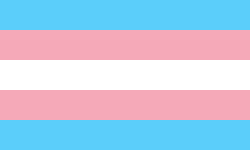
Gender and Gender Dysphoria
What we call gender can be understood in several ways. Here you can learn more about what gender is and how gender identity is formed.
This text is for people who work in sports; on a policy-making level, as trainers or in some other capacity.
What is trans?
Transperson is an umbrella term that applies to a wide range of identities, groups, and people who identify as trans in different ways. A trans person is someone who breaks society’s norms for gender and gender identity.
The thing that unites is that their gender identity and/or gender expression doesn’t match the gender they were assigned at birth because of the appearance/interpretation of their bodies.
Trans has nothing to do with sexuality, it’s about gender identity. Trans is not a sexual orientation.
What is gender?
Gender identity is the gender you feel like. It doesn’t have to correspond to what your body looks like. All people have the right to decide what their gender identity is.
Gender expression is how you express your gender identity. You can do that through your clothes, body language, hairstyle, by using or not using make-up, and your voice. Gender expression is a part of your social gender, which also includes interests, what role you take on in groups and different preconceptions based on gender.
Social gender can also be about how others perceive you.
Body refers to inner and outer genitalia, sex chromosomes and hormone levels; if you have ovaries, testicles, vagina, penis, higher or lower levels of estrogen or testosterone, XX- or XY-chromosomes. It can also refer to facial hair and other bodily hair and what your chest looks like. From a body point of view, there aren’t just two genders, rather there are multiple variations.
Legal gender is the gender that is registered in the population register. It’s in your passport and sometimes on your id-card. The legal gender also dictates the next to last digit in your personal identity number. Sweden recognizes two genders: male and female. Other countries have more legal genders, for example, Germany, Australia, and South Africa. In Sweden, the healthcare staff determines gender based on the appearance of the outer genitalia at birth.
What is gender dysphoria?
The Swedish National Board of Health and Welfare defines gender dysphoria as a mental suffering or a decreased ability to function because of incongruence between gender identity and the legal gender assigned at birth. If you suffer from gender dysphoria you get access to gender-affirming treatment.
Though it’s possible to diagnose, gender dysphoria isn’t an illness. The diagnose simply describes a need for contact with healthcare and some medical assistance. Here you can read more about gender dysphoria as a diagnosis.
Many trans people suffer from gender dysphoria. There are also many who don’t. You don’t have to experience gender dysphoria to be trans. It’s a condition that often covaries with a gender identity that doesn’t correspond to the gender assigned at birth.
How does gender identity develop?
Gender identity is often formed at an early age. Children who are only a few years old can usually determine what their gender identity is, or isn’t. Many live in accordance with the gender assigned at birth and may experience a vague – but sometimes strong – feeling that something is “wrong”, but be unable to put it into words.
Many people realise they’re trans in puberty. The effect puberty has on the body can make it more obvious that the assigned gender isn’t right. However, some people realise that they are trans as young adults or even later in life.
For some people the realisation may come in the meeting with other trans people; you suddenly find the words for something you already feel but haven’t been able to explain to yourself or others.
For most people, gender identity is a central part of who they are. For a small group of trans people, gender identity is fluid and they may identify as gender-fluid, i.e. their gender identity is changeable.
How is gender dysphoria diagnosed?
The accessibility of gender-affirming care varies greatly between countries. Gender assessment and gender-affirming treatment are both included in the publically financed healthcare in Sweden. Detailed investigations are conducted to make sure that people get the right care, especially in cases where the care consumer is under 18 years old.
In Sweden, so-called gender assessments are made by expert teams in specialist psychiatry at many university hospitals. The waiting time for the assessment teams is often multiple years, especially for those under the age of 18.
The assessment of people who are under 18 years old takes years to complete. For adults, the assessment is slightly shorter. The assessment aims at investigating if someone is experiencing gender dysphoria and if gender-affirming care is suitable for them. Just as in other assessments the teams look for signs of mental ill-health or other health issues that need to be addressed instead or first.
The teams making the assessment consist of people with expertise in gender dysphoria. There’s usually a psychiatrist (a doctor specialised in psychiatry), psychologist and a counselor (social worker) on the team. Apart from that, there are specialists such as endocrinologists (hormone doctors), surgeons and speech therapists (voice and communication specialists). If you want to change your legal gender, you need to have been in contact with an assessment team for at least two years.
Just like other assessments in psychiatry a gender assessment is based on conversations and standardized tests (often forms that are filled out by the care consumer). The psychosocial assessment is important. The care consumer and the counselor map out the care consumer’s social networks and what important people they have around them.
In gender assessments of children, it’s especially important that the child’s family is involved. Not everybody who is diagnosed with gender dysphoria wants gender-affirming care, but many need gender-affirming treatment to ease gender dysphoria.
Gender-affirming care
After being diagnosed with gender dysphoria you get access to gender-affirming treatment. That means for example hormone treatment and different surgical procedures for people who are 18 years old or older. In a limited number of cases people younger than 18 can receive some form of care, for example hormones that block puberty and, in rare cases, hormone treatment from the age of 16.
In order to change legal gender, you have to have been in contact with a gender assessment team for at least two years, be older than 18 and be nationally registered in Sweden. The application is addressed to the Swedish National Board of Health and Welfare’s judicial council. You also apply to the judicial council to have genital surgery.
Gender-affirming care is done in stages over several years. For those in need of surgical procedures, multiple operations are often needed, which entails time for recovery and healing and may have an impact on the ability to perform physical activities. Hormone treatment is life-long and it usually takes a few years to achieve maximum results.
You can read more about gender-affirming care at transformering.se.

